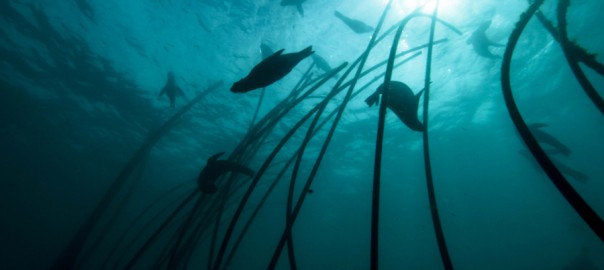Since 2011 Shark Diving Unlimited sponsored the field work for the PhD project of the now Dr. Craig P. O’ Connell (Marine Biologist, O’Seas Conservation Foundation http://www.oseasfdn.org), from the University of Massachusetts Dartmouth, providing the materials and the logistic support for his work.
Craig’s PhD was focused on the usage of permanent magnets to change the swimming pattern and deter large predatory sharks.This project, authorized by the Department of Environmental Affairs of South Africa (Res Permit RES2012/74), and thanks to Michael Rutzen’ s personal observations, developed further into a novel technology that combines the magnets with a visual biomimicry barrier that looks like a kelp forest.
The whole project became a huge team effort between Craig, Michael Rutzen, Prof. C.A. Matthee (Stellenbosch University) and Sara Andreotti (PhD student, Stellenbosch University) which resulted in the development of what is now known as the Sharksafe Barrier.
LINK TO THE 50/50 CHANNEL WITH SHARKSAFE BARRIER:
The aim of this project is to find an alternative solution to anti-sharks nets to protect both beach goers and sharks of our coastline.
Have a look at the photos on the Sharksafe facebook page:
https://www.facebook.com/Sharksafebarrier
The result of the first year of work with the magnets was published in Ocean and Coastal Management: http://dx.doi.org/10.1016/j.ocecoaman.2012.11.006 .
Craig successfully experimented the Sharksafe also on bull sharks in Bimini Bahamas:
Craig came back to South Africa every year since 2011, to continuously test the efficacy of the Sharksafe barrier on white sharks.
The results of the novel Sharksafe technology efficacy on white sharks are published on the Experimental Journal of Marine Biology and Ecology:
O’Connell, C. P., Andreotti, S., Rutzen, M., Meÿer, M., Matthee, C. A. & He, P. 2014 Effects of the Sharksafe barrier on white shark (Carcharodon carcharias) behavior and its implications for future conservation technologies. Journal of Experimental Marine Biology and Ecology 460, 37–46. (doi:10.1016/j.jembe.2014.06.004)
Have a look at the abstract here:
http://www.sciencedirect.com/science/article/pii/S0022098114001671
Check out some videos of the field work:
http://www.youtube.com/watch?feature=player_embedded&v=Oq09WOku88A
